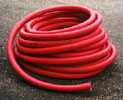|
|
|
| A. Retrieval Float B: Trip Line Support Float C: FPA Trip Line D: Weight E: Para-Ring |
F: Anchor Rode G: Snatch Block H: FPA Pendant Line I: Pendant Line Support Floats J: Chafe Gear |
Para-anchor is short for "parachute sea anchor." This large-diameter parachute system is used to "anchor" a boat in water too deep for ground tackle. Its design stops the vessel's forward progression through the water and stabilizes its position to the wind. Initially designed from selected cargo chutes at the end of World War II, modern para-anchors catch more water than canvas sea anchors used in centuries past. Due to the increased holding power of the new para-anchor, the effectiveness of vessel stability during rough seas has now expanded to fit all boat designs. Parachute anchors are still generally referred to as sea anchors by some sailors and manufacturers. They come in a variety of sizes.
|
|
|
| A. Retrieval Float B: Trip Line Support Float C: FPA Trip Line D: Weight E: Para-Ring |
F: Anchor Rode G: Snatch Block H: FPA Pendant Line I: Pendant Line Support Floats J: Chafe Gear |
|
|
|
 |
A: Retrieval Float:
(Optional Accessory) The last float marking the tail end of the floating trip line. The Benefit: High degree of visibility allows a skipper to easily motor toward the retrieval float to capture the trip line. Large enough to prevent the para-anchor from sinking too deep under the water when anchor rode is slack. Return to Top |
 |
B: Trip Line Support Float
(Optional Accessory) A small float secured in the center of a floating trip line. The Benefit: Provides necessary tension in trip line to avoid slack. Also serves as an excellent marker to help determine para-anchor depth. Return to Top |
 |
C: Fiorentino Trip Line
(Optional Accessory) Used to help in deflation and recovery of the para-anchor. Trip lines vary in length from 50 to 100 feet on typical vessels, and up to 1,000 feet for those with deep drafts and high freeboards. The Benefit: Enables the top of the canopy to be pulled more easily to the boat. Return to Top |
 |
D: Weight
(Standard) One-to five-pound egg weights sewn onto one side of the Fiorentino Para-Anchor's canopy. The Benefit: Reduces parachute rotation and prevents shrouds from twisting. Weight placement aids the para-anchor's capabilities by holding it deeper beneath the water and away from breaking seas. Return to Top |
 |
E: Fiorentino PARA-RING
(Standard) Serves
as an attachment point for the anchor rode and maintains a wide spread of shroud
lines, which enables the anchor stabilizer to more easily self-adjust. The anchor
stabilizer rotates and tilts as environmental forces penetrate the canopy and
produce potentially damaging energy that is transmitted through the shroud lines
to the Para-Ring. The Benefit: In boiling seas and strong ocean currents, the self-adjusting Para-Ring prevents the elements from pushing, rolling, or spinning a parachute anchor out of control, which can lead to a tangled parachute or blown out canopy panel. Para-anchor balance is achieved as the Para-Ring self-adjusts to uneven shock loads that are carried down the shroud lines from the canopy. The tilting of the Para-Ring neutralizes the mixed energy to create an even pull on the parachute canopy. Return to Top |
 |
F: Anchor Rode
(Mandatory Accessory) A strong, braided nylon rope that connects the parachute anchoring system to the bow of a vessel. The amount of rode needed during deployment depends on a vessel's response to various weather conditions - usually 10 feet of rode for every foot of boat. The Benefit: Because it stretches under tension, the rode absorbs massive shock loads. Return to Top |
 |
G: Snatch Block (Optional Accessory) A stainless steel swivel block, with a hinge or sliding plate shell that opens to allow a bight of a rope to pass through. The Benefit: The block's ability to open allows the block to be clamped over anchor rode in the event that rigging a bridle becomes necessary. Return to Top |
 |
H: Fiorentino Pendant Line
(Optional Accessory) A stiff length of rope with a block at the end. The diameter of the pendant line matches that of the anchor rode. Line length is dependent upon size of the vessel. The Benefit: When attached to the anchor rode, the pendant line can be connected to a stern winch to form a bridle, which is then used to hold a vessel in a heave to position during heavy seas. Return to Top |
 |
I: Pendant Line Support Floats
(Optional Accessory) Two small floats located
near the snatch block. The Benefit: These floats keep the pendant line afloat whenever it becomes slack. Return to Top |
 |
J: Chafe Gear
(Optional Accessory) Rubber tubing or fire hose used to protect lines from wear. The Benefit: Wrapped around the pendant line or anchor rode, this chafe protection reduces wear caused when the line rubs against the vessel and her rigging. Return to Top |